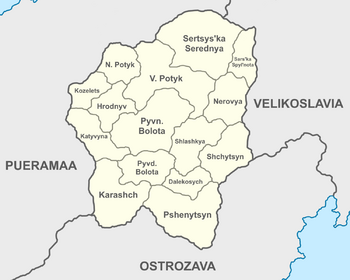Zamorodna: Difference between revisions
mNo edit summary |
mNo edit summary |
||
| Line 133: | Line 133: | ||
====Radastva==== | ====Radastva==== | ||
===Military=== | |||
==Economy== | ==Economy== | ||
Revision as of 20:30, 17 November 2021
This article is incomplete because it is pending further input from participants, or it is a work-in-progress by one author. Please comment on this article's talk page to share your input, comments and questions. Note: To contribute to this article, you may need to seek help from the author(s) of this page. |
Zamorodnian Hetmanate Замородинський гетьманство | |
|---|---|
 | |
| Capital | Porozhamina |
| Official languages | Zamorodnian |
| Ethnic groups |
|
| Religion |
|
| Demonym(s) | Zamorodnian |
| Government | Confederal minarchist elected autocracy |
• Hetman | Olehsyy Bohdanuk Petrenko |
• Koshovyy Otaman | Volodymyr Matvyyuk Nesterenko |
| Legislature | Starshyna |
| Establishment | |
• Great Kozak Migration | 1332-1426 CE |
• Unification of the Hosts | 1538 CE |
• Independence from Suvarova | 1672 CE |
| Population | |
• Estimate | 14,293,012 (2021) |
| GDP (nominal) | estimate |
• Total | $178.6 billion (2021) |
• Per capita | $12,494.43 |
| Gini | medium |
| HDI | medium |
| Currency | Hrivenka (₴) (ZHR) |
| Date format | yyyy-mm-dd (CE) |
| Driving side | right |
| Calling code | +443 |
| Internet TLD | .zam |
The Zamorodnian Hetmanate (Zamorodnian: Zamorodyns'kyy Het'manstvo), also known as Zamorodna or Zamorodina, is a small, landlocked nation in northern Belisaria. Zamorodna is the homeland of the Kozak peoples, who migrated westward from the Altunid and Ikdemid Khanates in the high middle ages, settling in a harsh, swampy region in the western hinterlands of Suvarova. The Great Kozak Host was an autonomous nation under the Crown of Suvarov, but gained independence in 1672.
In the present day, Zamorodna is a culturally integrated but politically disunified entity. The various constituent polities of the Hetmanate, the Tovarystva, have varying degrees of authoritarian or democratic and capitalist or socialist elements. As such, the Tovarystva can often be isolationist, particularly from very different neighbours. However, the unified culture, language, and traditions of the Kozaks tie the Tovarystva together.
Economically, Zamorodna is self-sufficient but only moderately-to-poorly industrialized. Approximately one-third of the population are traditional pastoralists. Mining and other resource extraction are growing industries and leading sectors in the export economy. Domestically, economic figures can be difficult to ascertain due to limited governmental oversight and a widespread informal economy.

